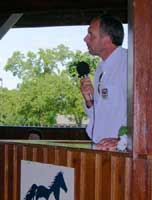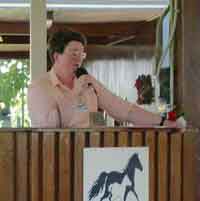British Rare Breeds on Parade! | Events | Instructional Show | Clinic Topics | Staff & Volunteers
Report: Clinic Topics at "British Rare Breeds on Parade!"
SATURDAY, June 21st
DNA Rare Breed Studies: How Healthy are Your Genomes? – Dr. E. Gus Cothran/University of Kentucky
A brief, but comprehensive and understandable explanation of what DNA studies can tell us about rare breeds as compared to common breeds. Conservation of rare breed genetics is important but difficult due to the risk of fixing genetic defects in a closed population. DNA testing is advisable for all rare breed individuals, and results are acceptable both in America and Europe. The UN's Domestic Animal Diversity initiative aims to measure as many populations globally as possible.
 British Native Breeds: Under the Influence – Clive
Richardson
British Native Breeds: Under the Influence – Clive
Richardson
Clive took a necessarily condensed look at the effect of environment and usage from prehistory to 20th C. He corrected a much reproduced misprint in one of his books in passing! He discussed types: from pack to harness to saddle, including the emergence of fixed, reproducible breed types in the 1800's. There was also some discussion of the many breeds we have lost: no market, no purpose, no breed.
SUNDAY, June 22nd
Partners in Conservation - Charles Bassett
Chuck Bassett, Executive Director of ALBC, gave an insight into the Conservancy's role in conserving rare breeds alongside the supporters and breeders of these animals. A lively question and answer period followed with discussion that emphasized support for more ALBC equine activities and networking.
 Where Do We Go From Here? - Sue Millard
Where Do We Go From Here? - Sue Millard
Modern markets vs traditional stock. Is breed type, conformation, or usage the main criterion for selection of rare breed breeding stock? How does the sale of youngstock without performance testing affect the breeds? "Fashions" and the role of the show judge in preserving rare breed characteristics. The need for co-operation and networking between breeders in America and in their breeds’ homelands.